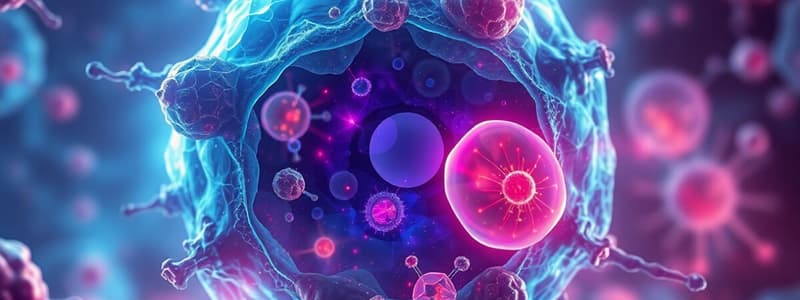Podcast
Questions and Answers
Who is credited with the discovery of the cell?
Who is credited with the discovery of the cell?
- Matthias Jakob Schleiden
- Theodor Schwann
- Robert Hooke (correct)
- Louis Pasteur
Which statement is not part of the modern interpretation of cell theory?
Which statement is not part of the modern interpretation of cell theory?
- All cells share the same basic chemical composition.
- Cells contain chloroplasts for energy metabolism. (correct)
- Energy flow occurs within cells.
- All living organisms are made of one or more cells.
What type of cell is described as having a well-organized nucleus?
What type of cell is described as having a well-organized nucleus?
- Prokaryotic cell
- Fungal cell
- Eukaryotic cell (correct)
- Bacterial cell
What feature is unique to prokaryotic cells?
What feature is unique to prokaryotic cells?
Which of the following describes all cells in organisms of similar species?
Which of the following describes all cells in organisms of similar species?
In which type of cell are plasmids typically found?
In which type of cell are plasmids typically found?
What does the cell theory suggest about the origin of cells?
What does the cell theory suggest about the origin of cells?
Which of the following is characteristic of eukaryotic cells?
Which of the following is characteristic of eukaryotic cells?
Flashcards
Cell Theory
Cell Theory
A fundamental principle in biology stating that all living organisms are composed of one or more cells, the cell is the basic unit of life, and all cells arise from pre-existing cells.
Prokaryotic Cell
Prokaryotic Cell
A simple type of cell lacking a membrane-bound nucleus and other organelles. Examples include bacteria and blue-green algae.
Eukaryotic Cell
Eukaryotic Cell
A complex type of cell with a membrane-bound nucleus and other organelles. Examples include plants, animals, fungi, and protists.
Nucleoid
Nucleoid
Signup and view all the flashcards
Plasmids
Plasmids
Signup and view all the flashcards
Organelles
Organelles
Signup and view all the flashcards
Merozygotic
Merozygotic
Signup and view all the flashcards
Histones
Histones
Signup and view all the flashcards
Study Notes
Cell Theory
- Robert Hooke discovered the cell in 1665, describing it in Micrographia.
- Theodor Schwann and Matthias Schleiden developed the Cell Theory.
- All living organisms are composed of one or more cells.
- The cell is the basic unit of life.
- All cells arise from pre-existing cells.
Modern Interpretation of Cell Theory
- All known living things are made of one or more cells.
- All living cells arise from pre-existing cells via division.
- The cell is the fundamental unit of structure and function in living organisms.
- An organism's activity depends on the combined activity of independent cells.
- Metabolism and biochemical processes occur within cells.
- Cells contain DNA, specifically within chromosomes, and RNA found in the cell nucleus and cytoplasm.
- Cells of similar species share a similar chemical composition.
Modern Cell Theory Version 2
- Energy flow occurs within cells.
- Heredity information (DNA) is passed from cell to cell.
- All cells have the same basic chemical composition.
Types of Cells
- Prokaryotic cells: These cells are primitive, unorganized, and lack a nucleus (karyon - nucleus). Examples include bacteria, blue-green algae, mycoplasma, rickettsia, and actinomycetes.
- Eukaryotic cells: These cells are advanced, organized, and have a true nucleus (eu - true). Examples include protozoans, animal cells, plant cells, and fungal cells.
Prokaryotic Cell Structure (Diagram)
- Capsule
- Cell Wall
- Plasma Membrane
- Cytoplasm
- Ribosomes
- Plasmid
- Pili
- Bacterial Flagellum
- Nucleoid (circular DNA)
Eukaryotic Cell Structure (Diagram)
- Cell Wall
- Cell Membrane
- Golgi Apparatus
- Chloroplast
- Vacuole Membrane
- Smooth Endoplasmic Reticulum (no ribosomes)
- Nucleolus
- Nucleus
- Rough Endoplasmic Reticulum (ribosomes)
- Large Central Vacuole (amyloplast/starch grain)
- Mitochondrion
- Cytoplasm
- Ribosomes
- Golgi Vesicles
- Raphide Crystal
- Druse Crystal
Prokaryote vs. Eukaryote Comparison
-
Prokaryotes*
-
Size: 1-2 by 1-4 μm or less
-
Genetic material: Nucleoid, one circular chromosome, no histones
-
Structure: No membrane-bound organelles, small ribosomes (70S), functionally related genes clustered
-
Growth: Zygote - merozygotic
-
Cell wall: Peptidoglycan
-
Other differences: Gas vacuoles and mesozomes present, cytoplasmic streaming and pinocytosis absent.
-
Eukaryotes*
-
Size: > 5 μm
-
Genetic material: Well-organized nucleus, more than one chromosome, histones present
-
Structure: Membrane-bound organelles present, large ribosomes (80S),
-
Growth: Zygote - diploid
-
Cell wall: No peptidoglycan
-
Other differences: Cytoplasmic streaming and pinocytosis present
Prokaryote vs. Eukaryote (continued)
- Prokaryote*
- Mitochondria - absent
- Chloroplast - absent
- Golgi bodies - absent
- Endoplasmic reticulum - absent
- Eukaryote*
- Mitochondria - present
- Chloroplast - present
- Golgi bodies - present
- Endoplasmic reticulum - present
Studying That Suits You
Use AI to generate personalized quizzes and flashcards to suit your learning preferences.
Related Documents
Description
Explore the foundations of Cell Theory and its modern interpretations through this quiz. Understand the contributions of key scientists like Robert Hooke, Theodor Schwann, and Matthias Schleiden, and how they shaped our understanding of life at the cellular level. Test your knowledge on the structure, function, and metabolism of cells.




